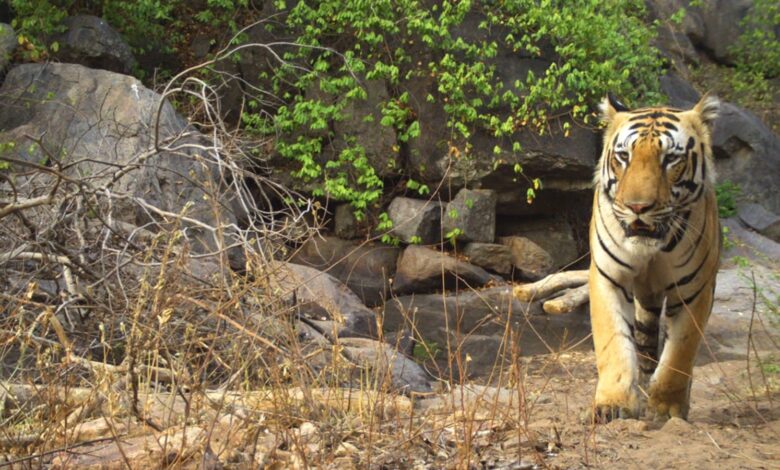Surprise visitor at wildlife sanctuary that hasn’t had a big cat for four decades — a young male tiger | India News

This March, Chhattisgarh’s Barnawapara Wildlife Sanctuary had an unusual visitor – a young male tiger who has now made the forest his new home. For a jungle that hasn’t hosted tigers for nearly 40 years, the new resident brought in a ray of hope — forest authorities are now planning to get the young male two female mates in a bid to revive its extinct tiger population.
According to the forest officials, the department was alerted of the presence of their new resident — a four-year-old male — earlier this year. Although attempts to identify where the tiger came to naught — it wasn’t found on the national wildlife database maintained by the Dehradun-based Wildlife Institute of India (WII) – officials have been tracking its movements since, even writing to the India’s apex tiger monitoring body National Tiger Conservation Authority (NTCA) for two more female tigers as mates.
This comes at a time when Chhattisgarh is making efforts to increase its falling tiger population. As reported by The Indian Express in August, an NTCA report from 2023 showed that Chhattisgarh’s tiger population had fallen to 17 in 2022 from 46 in 2014.
According to Additional Principal Chief Conservator of Forest (Wildlife) Prem Kumar, the state has conducted two surveys to find out if Barnawapara Wildlife Sanctuary can sustain a larger tiger population. Spread across 244.66 sq. km, this forest is already home to 44 species, including leopards, elephants, sloth bears, guars, spotted deer, and the Indian wolf.
The last time a tiger was spotted in these parts was over a decade ago.

The department hopes that reviving the sanctuary’s tiger population would help boost tourism in these parts. “The survey found a sufficient prey base — wild boars and chitals – and adequate water availability to house two more tigers,” Kumar said.
To protect the lone tiger, meanwhile, the department has taken several measures, including setting up 200 camera traps and conducting regular night patrols to ensure that the animal is safe from poachers.
“A dedicated team is formed to help in tracking and tracing the movements so that advance information can be shared with other staff. Night patrolling is being done on a rotation basis to ensure its protection and thwart any outside threat (such as poachers),” Baloda Bazar divisional forest officer Mayank Agrawal told The Indian Express.
Forest officials have also enlisted the aid of cattle herders from villages in the periphery of the sanctuary.
“We held a meeting with all the cattle herders to make them aware that the government would provide them with compensation in case the tiger preys on their cattle. They will also be rewarded when they alert us about poachers. Further, we are also taking measures to ensure poachers do not attack the animal,” he said, adding that the department recently arrested two poachers and seized two country-made guns from them.
Chhattisgarh has currently three tiger reserves — Achanakmar, Udanti Sitanadi and Indravati. In August, the state’s Vishnu Deo Sai cabinet cleared a proposal to notify Guru Ghasidas-Tamor Pingla Tiger Reserve as the state’s fourth tiger reserve – and the third largest in the country. The government plans to bring out a notification on this soon.
Significantly, the forest department also planned to bring two female and one male tiger to Achanakmar Tiger Reserve (ATR) but dropped it after the reserve saw its tiger numbers more than double, going to 12 in 2024 from five in 2022.
According to ATR Deputy Director U.R. Ganesh, this change is owing to two major factors.
“One is the increase in tiger population in protected areas of neighbouring Madhya Pradesh. The corridor connectivity enables this spill over tiger population to relocate to ATR. Second, our constant efforts to provide them a safe and suitable habitat given the initiatives being taken to undertake habitat improvement activities along with patrolling, surveillance and protection,” he said.
But there could be challenges involved in the forest department’s plans to revive Barnawapara’s tiger population. According to wildlife conservationist and activist Ajay Shankar Dubey, the department has two main tasks – protecting the area’s prey base and keeping the sanctuary clear of poachers and encroachments.
“Tigers are an indicator of a healthy forest… (But) in Chhattisgarh, there are two challenges. First is taking care of the food cycle and for that, they need to protect the weakening of prey base as tigers can survive when there is better grassland management. Second is protection from hunting. So, forest officials will have to be vigilant,” he said.






